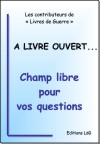le Glossaire de Francis a trouvé :| - | Dans le cadre de l'organisation de la Résistance, la lettre R suivie de 1 à 6 indiquait une région de la zone Sud (zone non occupée jusqu'en 1942).
R1 : Région Rhône-Alpes (centre Lyon).
R2 : Région Provence-Côte d'Azur (centre Marseille).
R3 : Région Languedoc-Roussillon (centre Montpellier).
R4 : Région du Sud-Ouest (centre Toulouse).
R5 : Région de Limoges (centre Brives puis Limoges).
R6 : Région de l'Auvergne (centre Clermont-Ferrand).
En zone Nord occupée, les régions étaient définies par les simples lettres : P - A - B - C - D - M
(voir "zone")
|
| - | En Belgique: nom définitif donné le 1 juin 1944 à la Résistance belge après la fusion de plusieurs groupements de résistance.
|
| - | En France. Sous le commandement du général Charles Delestraint, l'AS tente de coordonner les différents mouvements de résistance. L'AS trouvera se place dans la Résistance avec le développement des maquis qui offrent aux militaires la possibilité d'encadrer des "troupes".
|
Dans ce texte : Pour ceux qui s'intéressent aux tanks de Leon le lundi 05 mars 2007 à 09h44 Pour ceux qui s'intéressent aux tanks de Leon le lundi 05 mars 2007 à 09h44
Bonjour à tous,
Voici une histoire extraordinaire. L'histoire d'un tank russe, pris puis utilisé par les allemands en 44 en Estonie, (Front de Narva), puis abandonné dans un lac durant la retraite de ces derniers. Je vous résume le texte intégral en anglais:
En septembre 2000, un jeune garçon découvre des traces de tank dans la forêt, qui mènent au lac mais n'en ressortent pas. Il prévient le représentant local du Musée de la guerre local. Une mission d'exploration puis, plus tard, de "renflouage" est organisée, à grand renfort d'hommes et de matériel (bull dozer). Le blindé de 27 tonnes git à 7 m de profondeur, sous une couche de 3m de vase.
L'opération prend 6 heures, émaillée de difficultés diverses, bien entendu. Une fois sorti de l'eau et de la boue, il s'avère qu'il est en bon état, pas rouillé et que toutes ses pièces (excepté le moteur) sont en état de marche. 116 obus sont découverts à l'intérieur.
Il est (ou sera) restauré et exposé au musée de Gorodenko; Aux dernières nouvelles, son moteur diesel est à nouveau en état de marche !
14 September 2000, a Komatsu D375A-2 pulled an abandoned tank from its archival tomb under the bottom of a lake near Johvi, Estonia. The Soviet-built T34/76A tank had been resting at the bottom of the lake for 56 years. According to its specifications, it's a 27-tonne machine with a top speed of 53km/h.
From February to September 1944, heavy battles were fought in the narrow, 50 km-wide, Narva front in the north-eastern part of Estonia. Over 100,000 men were killed and 300,000 men were wounded there. During battles in the summer of 1944, the tank was captured from the Soviet army and used by the German army. (This is the reason why there are German markings painted on the tank's exterior.) On 19 September 1944, German troops began an organized retreat along the Narva front. It is suspected that the tank was then purposefully driven into the lake, abandoning it when its captors left the area.
At that time, a local boy walking by the lake Kurtna Matasjarv noticed tank tracks leading into the lake, but not coming out anywhere. For two months he saw air bubbles emerging from the lake. This gave him reason to believe that there must be an armored vehicle at the lake's bottom. A few years ago, he told the story to the leader of the local war history club 'Otsing'. Together with other club members, Mr. Igor Shedunov initiated
diving expeditions to the bottom of the lake about a year ago. At the depth of 7 metres they discovered the tank resting under a 3-metre layer of peat.
Enthusiasts from the club, under Mr Shedunov's leadership, decided to pull the tank out. In September 2000 they turned to Mr Aleksander Borovkovthe,manager of the Narva open pit of the stock company AS Eesti Polevkivi, to rent the company's Komatsu D375A-2 bulldozer.
The pulling operation began at 09:00 and was concluded at 15:00, with several technical breaks. The weight of the tank, combined with the travel incline, made a pulling operation that required significant muscle. The D375A-2 handled the operation with power and style. The weight of the fully armed tank was around 30 tons, so the active force required to retrieve it was similar. A main requirement for the 68-tonne dozer was to have enough weight to prevent shoe-slip while moving up the hill.
After the tank surfaced, it turned out to be a trophy tank, that had been captured by the German army in the course of the battle at Sinimaed (Blue Hills) about six weeks before it was sunk in the lake. Altogether, 116
shells were found on board. Remarkably, the tank was in good condition, with no rust, and all systems (except the engine) in working condition.
This is a very rare machine, especially considering that it fought both on the Russian and the German sides. Plans are under way to fully restore the tank. It will be displayed at a war history museum, that will be founded
at the Gorodenko village on the left bank of the River Narv.
Ci dessous, 1 Photo de l'opération de "renflouage". Autres photos disponibles, pour ceux que cela intéresse.
A plus tard, Frédérique *** / *** |



 Temps entre début et fin du script : 0.07 s 3 requêtes
Temps entre début et fin du script : 0.07 s 3 requêtes